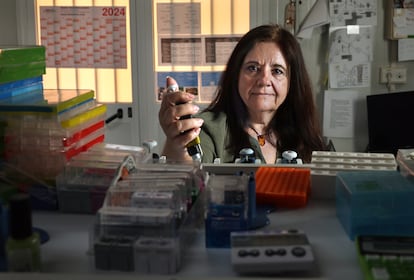Laura López-Mascaraque, research scientist: ‘Each person has a unique smell: this is our olfactory footprint’
The scientist spoke with EL PAÍS about the association between smell and memory. ‘It’s the only sense that’s not filtered by the brain,’ she notes, pointing out how scent goes directly to the amygdala — which processes emotions — and the hippocampus, which has a major role in memory. López-Mascaraque also discussed the future of disease detection and criminal investigation through olfaction

Laura López-Mascaraque is a research scientist at the Spanish National Research Council (CSIC) and directs a working group at the Cajal Institute in Madrid.
This native of Madrid is also the president of the Spanish Olfactory Network and she was previously the president of the Women’s Committee of the Spanish Society of Neuroscience (SENC). She is co-author of the book El olfato (The Sense of Smell), which she wrote with José Ramón Alonso.
On Tuesday, June 4, López-Mascaraque received EL PAÍS in her office. Outside, on the street, it smelled of lavender and summer.
Question. How many genes do we have that are dedicated to our sense of smell?
Answer. Today, functionally, we have exactly 396 genes that regulate the processing of odors in the brain. When this became known to us, it was a huge surprise that there were so many.
Q. For eyesight, for example, how many genes do we use?
A. Three. The basic colors. And yet, 3% of the human genome is dedicated to smell. It’s much more important than we imagine. All animals — and all humans — have depended greatly on the sense of smell for everything. The brain was once almost olfactory. As we evolved, the entire cerebral cortex and the other regions [of the brain] were formed. We humans evolved in a way that gave more prominence to other senses: we became bipedal, we separated our nose from the ground and we sharpened [other] senses, such as sight or hearing, which are the ones that are now the main focus of our lives.
Q. Our eyesight has become worse as we needed it less, as we had things closer at hand. What about our sense of smell?
A. Throughout history, the evolution of smells has been very special. If you explore the ancient culture of the Egyptians, smells were a cult to the gods: they offered them aromas. The legend of the Three Wise Men… what did they offer baby Jesus? Gold, incense and myrrh. Frankincense and myrrh were scents. Back then, they compared them to gold.

Q. What happened to our sense of smell during the pandemic?
A. Suddenly — by losing their sense of smell — people realized how important it was. For example, [for some of those infected with Covid-19], things didn’t have flavor: all they had were [the five basic] tastes: sweet, salty, bitter, sour and umami. If you had peppermint without knowing what it was, you would taste it and it would have no flavor. It may have tasted a little bitter. Just a bit. But you wouldn’t have detected that it was peppermint until you unclogged your nose. The same thing happened with cinnamon. To enjoy life, it’s important to enjoy flavors in general.
Q. In Mugaritz — one of the best restaurants in the world, owned by chef Andoni Luis Aduriz — they perform the test of sucking on a bitter-tasting white strip.
A. By having so many genes for smell, we have a unique olfactory register: that is, no one’s going to smell what you’re going to smell. This is also the case for taste. There are genes that are regulating how you like things. And there’s a group of people called supertasters, who have a special sensitivity to bitter taste.
Q. What does that mean?
A. It means that, in a stew, for example, you can detect — in detail — all the flavors it has. It’s genetically encoded. And you have a gene for that. You can do the genetic test: suck on that strip of paper that’s [treated] with a substance… and it may taste so horrible that you have to drink water, or it may not taste like anything at all. It’s like if you’re blonde or dark-skinned: it’s just how you are. In children, sensitivity to bitter taste is very high, that’s why they don’t want to eat vegetables, spinach, broccoli. It tastes bitter to them, they have to get used to it.
Q. And what’s the relation of scent to memory?
A. The olfactory memory process is very evocative. A certain smell comes to you and, at first, you have a hedonic sensation that can be good or bad. Why does this happen? Because the sense of smell is the only one of [the five] senses that isn’t filtered in the brain. You have some neurons in your nose, which are the only neurons that are in contact with the outside and that are renewed every 40 days. They process information for the brain to reach a structure called the olfactory bulb. With any other sense, the processing of a stimulus goes through the thalamus, which filters the information and tells it, “you’re going to go to the visual cortex, you’re going to the auditory cortex, or the frontal cortex,” or wherever. However, smell passes from the thalamus: it goes directly to its cortex. And it immediately connects with two very important structures in memory, which are the amygdala and the hippocampus.
Q. Which parts of the brain are those?
A. The amygdala is what processes emotions and the hippocampus processes memory. Now, what does this mean? That you’re not going to remember a smell: rather, [smelling a specific scent] is going to evoke a memory. You can think about the sea, but you can’t go beyond that. But if you smell it, smell takes you to memories, without you having to look for them.
Q. And what about people who have lost their memory?
A. I’ve done workshops with people with neurodegenerative problems — Alzheimer’s, Parkinson’s and other conditions — who have memory problems. And, [when presented with a certain smell], they’ve shown incredible symptoms of joy, or have simply started crying. Many older people have lost their sense of smell and food doesn’t excite them: it doesn’t taste like anything, it only nourishes them. If you use a flavor enhancer (like chocolate), it helps.
Q. You participated in a documentary that was broadcast in Spain called El sentido del cacao (The Scent of Cocoa).
A. It was about trying to restore the taste of chocolate to people who have lost their sense of smell or taste, either due to radiation from chemotherapy, or due to a traumatic accident. We tried to recreate that flavor and help them feel what they used to feel at that moment when they last tasted chocolate. People ended up crying. Just from tasting it, smelling it.
Q. Are there more smells today than ever before?
A. I don’t think so. Different smells, maybe. It’s been said that humans can detect millions of odors, depending on the concentration, the mixture of molecules and so on. But I don’t think we have more or less smells, just different ones.
Q. What are pheromones?
A. Pheromones are types of substances that aren’t processed in the olfactory epithelium, but rather in the vomeronasal epithelium. [But] they don’t exist in humans. Those pheromones that are said to be put in perfumes are myths. Could we have aromas that can have the function of pheromones? Probably. But they haven’t been discovered.
Q. So we don’t have pheromones.
A. There have been many attempts to observe pheromones [in humans]. The only [incidence] that seems to occur is when a woman is breastfeeding. Around the nipple, there’s an areola with small vesicles that could emit some type of pheromones… but not exactly pheromones. The human genome has been searched to see if these pheromones exist and it’s been found that they don’t.
Q. And does evil have a scent?
A. [Smiles]. Disease has a scent. And this is interesting, because many experiments are being conducted around this. The volatilome, for example: the molecules that you release through your breath. Each of us has a unique smell. This is called the olfactory fingerprint — our volatilome.
Already, in the Middle Ages, there was what they called the smell wheel: people brought their jars of urine to doctors. The doctors looked at the color, smelled it and even tasted it. From there, they knew, for example, that you had diabetes mellitus if [the urine] tasted like honey.
When I was little, I remember my mother telling me: “Breathe on me: you have a sore throat, or your stomach is bad.” What dogs can already detect, we’re trying to do with a sensor, which knows if you have cancer, diabetes, whatever. There are research groups in Israel and the United States that are designing smart watches: you can put a chip in them and, with that watch — if you have allergies — you can even bring it close to a food to see if it has lactose or gluten.
Q. And could this be used in criminology? If you don’t leave fingerprints, maybe you leave odors…
A. They’re studying whether they can detect the scent footprint of a person who has been in a certain place, yes. And there could be an olfactory fingerprint: another biomarker, like the iris of our eye. Because despite all the perfumes we carry on us, or the food we eat (because food changes the smell that you have, altering your own metabolism), you have a base smell that will never change, just like your fingerprint. This, of course, has many ethical problems. If you have a watch and you bring it close to someone, suddenly, you’ll know what’s happening to them. There’s still a lot of work to do.
Q. Odotypes are the olfactory identities of brands. Companies use them to stand out. Can you speak to this phenomenon?
A. When you have a smell that identifies a certain brand, that makes you stay on — or leave — the brand’s site. This already started with the Disney parks: they smelled like popcorn and attracted people. It continued in New York, at Abercrombie: at a certain point, it occurred to [the firm’s leadership] to add a scent to the store. [Abercrombie branches have] a very basic concept: it’s a dark store with tables displaying clothes. But they saw that people didn’t leave the store: they stayed. And they didn’t know why. Well, it was simply because they had applied an aroma.
Each brand is looking for their own odotype. Since I’m the president of the Olfactory Network [in Spain], I get contacted by a lot of places and I put them in touch with perfumers. Right now, half of the houses [in Spain] smell like Zara: Zara started with a scent that was like clean clothes, and then, they started selling it.
Q. And restaurants and grocery stores do it, too.
A. In fast food restaurants, for example. Those scents are now prohibited, but before, what they did was blow the smell of the hamburgers directly out from the kitchen. That way, people would come in. Of course, it evokes you, awakens memories or causes outright hunger.
Sign up for our weekly newsletter to get more English-language news coverage from EL PAÍS USA Edition
Tu suscripción se está usando en otro dispositivo
¿Quieres añadir otro usuario a tu suscripción?
Si continúas leyendo en este dispositivo, no se podrá leer en el otro.
FlechaTu suscripción se está usando en otro dispositivo y solo puedes acceder a EL PAÍS desde un dispositivo a la vez.
Si quieres compartir tu cuenta, cambia tu suscripción a la modalidad Premium, así podrás añadir otro usuario. Cada uno accederá con su propia cuenta de email, lo que os permitirá personalizar vuestra experiencia en EL PAÍS.
¿Tienes una suscripción de empresa? Accede aquí para contratar más cuentas.
En el caso de no saber quién está usando tu cuenta, te recomendamos cambiar tu contraseña aquí.
Si decides continuar compartiendo tu cuenta, este mensaje se mostrará en tu dispositivo y en el de la otra persona que está usando tu cuenta de forma indefinida, afectando a tu experiencia de lectura. Puedes consultar aquí los términos y condiciones de la suscripción digital.
More information
Últimas noticias
Most viewed
- Sinaloa Cartel war is taking its toll on Los Chapitos
- Oona Chaplin: ‘I told James Cameron that I was living in a treehouse and starting a permaculture project with a friend’
- Reinhard Genzel, Nobel laureate in physics: ‘One-minute videos will never give you the truth’
- Why the price of coffee has skyrocketed: from Brazilian plantations to specialty coffee houses
- Silver prices are going crazy: This is what’s fueling the rally











































